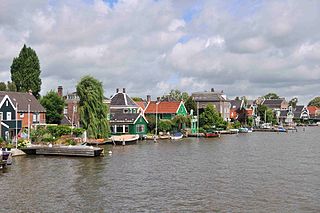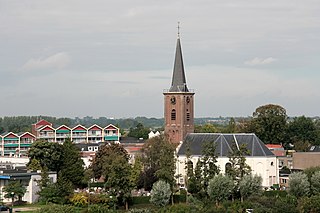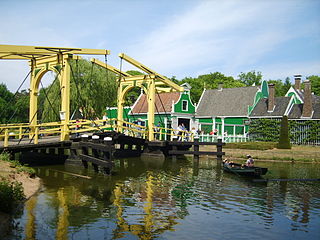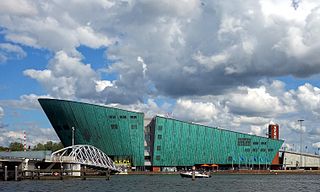
The Mauritshuis is an art museum in The Hague, Netherlands. The museum houses the Royal Cabinet of Paintings which consists of 854 objects, mostly Dutch Golden Age paintings. The collection contains works by Johannes Vermeer, Rembrandt van Rijn, Jan Steen, Paulus Potter, Frans Hals, Jacob van Ruisdael, Hans Holbein the Younger, and others. Originally, the 17th-century building was the residence of count John Maurice of Nassau. It is now the property of the government of the Netherlands and is listed in the top 100 Dutch heritage sites.

Zaanstad is a Dutch municipality in the province of North Holland, situated northwest of Amsterdam. Its main city is Zaandam. It is part of the conurbation and metropolitan area of Amsterdam. It had a population of 156,901 in 2021.

Zaandijk is a town in the municipality of Zaanstad, province of North Holland, Netherlands. It lies about 11 kilometres northwest of Amsterdam and had a population of 8,686 in 2017. Zaandijk is one of the smallest villages in Zaanstad, having a surface area of 209 hectare.

Koog aan de Zaan is a town in the Dutch province of North Holland. It is a part of the municipality of Zaanstad, and lies about 11 km northwest of Amsterdam.

The Kröller-Müller Museum is a national art museum and sculpture garden, located in the Hoge Veluwe National Park in Otterlo in the Netherlands. The museum, founded by art collector Helene Kröller-Müller within the extensive grounds of her and her husband's former estate, opened in 1938. It has the second-largest collection of paintings by Vincent van Gogh, after the Van Gogh Museum. The museum had 380,000 visitors in 2015.

Mijdrecht is a town in the Netherlands with about 16,000 residents. It is located in the municipality of De Ronde Venen, about 7 kilometres (4.3 mi) west of the main A2 motorway, between Utrecht and Amsterdam.

The Groninger Museum is an art museum in the city of Groningen in the Netherlands. The museum exhibits modern and contemporary art of local, national, and international artists.

Naturalis Biodiversity Center is a national museum of natural history and a research center on biodiversity in Leiden, Netherlands. It was named the European Museum of the Year 2021. Although its current name and organization are relatively recent, the history of Naturalis can be traced back to the early 1800s. Its collection includes approximately 42 million specimens, making it one of the largest natural history collections in the world.

The Netherlands Open Air Museum is a national open-air museum located in Arnhem. It focuses on the culture associated with the everyday lives of ordinary people, and demonstrating the old way of life in the Netherlands.

The National Maritime Museum is a maritime museum in Amsterdam in the Netherlands.

NEMO Science Museum is a science centre in Amsterdam, Netherlands. It is located in the Oosterdokseiland neighbourhood in the Amsterdam-Centrum borough, situated between the Oosterdokseiland and the Kattenburg. The museum has its origins in 1923, and is housed in a building designed by Renzo Piano since 1997. It contains five floors of hands-on science exhibitions and is the largest science center in the Netherlands. It attracts around 670,000 visitors annually, which makes it the eighth most visited museum in the Netherlands.

Zaanse Schans is a neighbourhood of Zaandam, near Zaandijk, Netherlands. It is best known for its collection of windmills and wooden houses that were relocated here from the wider region north of Amsterdam for preservation. From 1961 to 1974, old buildings from all over the region known as the Zaanstreek were relocated using lowboy trailers to the Zaanse Schans. Two of the windmills in the Zaanse Schans are preserved in their original site where they were first constructed, and therefore don't make up part of the relocated structures. The Zaans Museum, established in 1994, near the first Zaanse Schans windmill, is located south of the neighbourhood. This architectural reserve for Zaanse timber construction is a protected village scene because of its architectural-historical and landscape value. It developed into an international tourist destination with several million visitors every year: in 2016, there were 1.8 million, in 2017 – 2.2 million.

The Zaan is a small river in the province of North Holland in the northwestern Netherlands and the name of a district through which it runs. The river was originally a side arm of the IJ bay and travels 13.5 kilometers through the municipalities of Zaanstad and Wormerland north of Amsterdam, from West-Knollendam in the north to Zaandam in the south, where it empties into the IJ.

The Anne Frank House is a writer's house and biographical museum dedicated to Jewish wartime diarist Anne Frank. The building is located on a canal called the Prinsengracht, close to the Westerkerk, in central Amsterdam in the Netherlands.
The Museum Card, also known as the Museumkaart in Dutch, is a personal card that grants free entry to approximately 400 museums in the Netherlands for one year. It is available for purchase at many of the larger participating museums or online, with a temporary card issued when purchased from the museum. While most museums offer free entry to Museum Card holders, some museums may charge an additional fee for special exhibitions, but not for general collections.

Charley Toorop was a Dutch painter and lithographer. Her full name was Annie Caroline Pontifex Fernhout-Toorop.

Zaans Museum is a museum in Zaandam, Netherlands, located at the Zaanse Schans. It opened in 1998 to preserve and protect the heritage of the Zaan area. In 2009, the museum was extended with the addition of the Verkade Experience.

Museum de Fundatie is a museum for the visual arts in Zwolle, Netherlands. Museum de Fundatie forms part of the Hannema-de Stuers Foundation, to which Kasteel het Nijenhuis in Heino also belongs. Museum de Fundatie possesses a collection of visual arts, with works ranging from the end of the Middle Ages until the present day, collected by Dirk Hannema, former director of Museum Boijmans Van Beuningen. As well as the permanent collection, Museum de Fundatie organises new, wide-ranging exhibitions every three months. Museum de Fundatie recorded a record number of 310,000 visitors in 2015.

The Ubica buildings are two adjacent buildings standing at 24 and 26 Ganzenmarkt, in central Utrecht, the Netherlands. Number 24 is a rijksmonument. The first recorded mention of the buildings is from 1319. After centuries of residential use, the buildings were bought by the Ubica mattress company in 1913 and used until a devastating fire in 1989. The buildings were then squatted for 21 years, before being redeveloped into a hotel and café-restaurant in 2014.




















